
| Language | Free |
| Release Date | 2007.1.3 |
| Genre | life |
| Author | BabyCenter |
| File Size | https://www.babycenter.com |
| Rating | (5) |
Such a document can be very useful for every couple expecting to give birth. It is also important to note that this document should have 2-3 copies: one will stay with the parents and the other ones are given to midwives, obstetricians or any other medical personnel involved in your child’s delivery.
This document can be written by the parents themselves, but it’s better if they ask for help and advice from healthcare professionals. These professionals will be able to explain every point more thoroughly and give you some recommendations as well as tips on how to make your own personalised template.
Different hospitals and doctors have different procedures, but it’s very important to know that you can always discuss your birth plan with the hospital staff. They can give you much more information about how they work in terms of delivering babies and what is possible for them to do during labour.
It’s also worth mentioning that not all hospitals will ask for your birth plan before you give birth, but it’s still a good idea to have one. Many hospitals and doctors would like to know the preferences of their patients in advance, so they can provide them with everything they need during labour.
Your birth plan is important because it allows you to state your preferences for labour and delivery, so that everyone knows what’s most important to you before labour starts. This can help avoid potential problems during the labour or delivery process, such as disagreements with your healthcare provider about how you want to proceed or being in a situation where there is no clear plan of care.
A birth plan is a list of the specific things you want or don’t want during labour and delivery. It allows your healthcare provider to understand what your preferences are for various aspects of care, such as:
Having a birth plan can help you communicate your wishes to the people who will be with you during labour and delivery. However, it’s important to remember that in an emergency situation, healthcare providers may have to act quickly and do something different from what is in your birth plan.
If you have a partner, it’s a good idea to make sure they are familiar with your birth plan and can help discuss the options with healthcare providers if necessary. If you don’t have a partner or close family member who can be there for you during labour, you may want to consider asking a family member or friend who is willing and able to be your advocate with the healthcare team.
It’s also important for you to remember that during labour and delivery, even if you do have a birth plan, your needs will come first. You’re the one who’ll be having a baby. If you have questions about any of the decisions being made or if something doesn’t feel right to you, it is important for you to tell your healthcare provider why, whether it’s related to pain management, tests that are being done or procedures that may be performed.
Most healthcare providers will work to follow the birth plan you create, especially if they are aware of any special circumstances or preferences that you have. However, keeping your birth plan simple can help ensure that everyone understands it and can follow it easily.
You can create a birth plan at any point during pregnancy—the sooner, the better! Ideally, your plan should be written and signed before you go into labour so that it’s easier to follow. Discussing the birth plan with your health care providers is a good idea, especially if they have not seen this document before. If possible, ask them to read over and discuss any parts of the birth plan that they have questions or concerns about. If you and your health care providers are unable to agree on the birth plan, there may be a need for a change in prenatal care providers until after delivery.